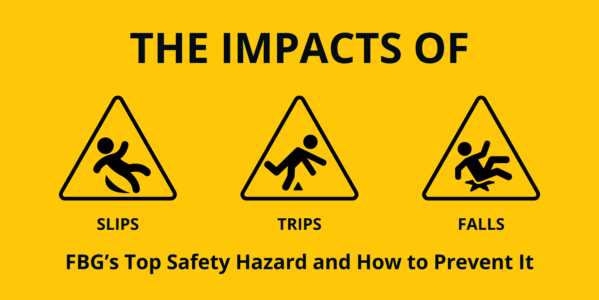The Impacts of Slips, Trips and Falls

Slips, trips and falls are the leading cause of workplace injuries at FBG. As the top safety hazard across our facilities, preventing these incidents is not just a priority, it’s essential. Fortunately, with consistent attention to walkways, lighting and cleanliness, we can reduce risks and create safer environments for everyone.
Identifying Hazards
The first step in prevention is identifying potential dangers. Common workplace hazards that contribute to slips, trips and falls include:
1. Wet Floors
Spills, mopping and tracked-in moisture can make floors slick and hazardous. Mark any wet areas with caution signs and use absorbent materials when needed. Report spills right away, or better yet, clean them up immediately.
2. Cluttered Walkways
Boxes, cords, equipment and other clutter left in pathways create tripping hazards. Keep workspaces neat and hallways clear. A well-organized area is a safer one.
3. Uneven Surfaces
Loose floor mats, cracked tiles and transitions between flooring types can catch unsuspecting feet. Watch your step and report any flooring issues promptly so they can be addressed before someone gets hurt.
Safe Walking Practices
Practicing safe walking habits helps reduce the risk of accidents and sets a good example for others.
1. Walk, Don’t Rush
Maintain a steady, controlled pace. Rushing increases the likelihood of missing a hazard.
2. Pay Attention
Stay off phones and avoid other distractions while walking. Watch where you’re going so you can respond quickly to anything in your path.
3. Wear Proper Footwear
Non-slip, supportive shoes make a big difference, especially in areas prone to moisture. Dress for your work environment to stay steady on your feet.
4. Use Handrails
Stairs and ramps are safer when you use handrails, especially when carrying items or if the surface may be wet.
Read More: How FBG Prioritizes Safety Year Round
Housekeeping Protocols
Good housekeeping isn’t just about appearance, it’s a critical part of workplace safety.
1. Clean Regularly
Spills, debris and disorganization create hazards. Regular cleaning and maintenance keep environments safer and more efficient.
2. Store Items Safely
Designated storage areas prevent tools and supplies from becoming obstacles. Keep walkways clear and items properly stowed.
3. Dispose of Waste Properly
Trash that piles up can cause trips or obstruct exits. Empty bins often and follow disposal procedures for all materials.
4. Use Clear Signage
Mark wet floors, maintenance areas or other hazards with proper signage to alert coworkers and reduce accidents.
Read More: Mastering Housekeeping in the Workplace: Planning, Practices and Safety